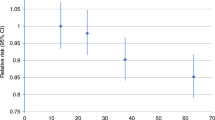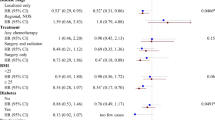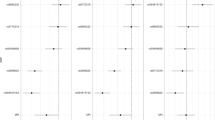Abstract
During the 1970s and 1980s, a number of factors emerged that were associated with the risk of breast cancer. The majority of these were not modifiable factors and, although much had been learned about breast cancer risk, this information could not be easily translated into recommendations to women for lowering their breast cancer risk. These factors were considered in developing the hypothesis that physical activity would be associated with breast cancer risk, with women who participated consistently in exercise activity having lower risk than inactive women. Since the mid-1990s a large series of case–control studies and cohort studies have confirmed that physical activity is a modifiable risk factor for breast cancer. Further, when physical activity is a persistent lifestyle practice, reductions in risk are quite clear, with vigorous activities possibly more protective against breast cancer than moderate forms of activity. Thus, maintaining a physically active lifestyle, which has broad health benefits, additionally has the potential to lower breast cancer risk.
This is a preview of subscription content, access via your institution
Access options
Subscribe to this journal
Receive 50 print issues and online access
$259.00 per year
only $5.18 per issue
Buy this article
- Purchase on Springer Link
- Instant access to full article PDF
Prices may be subject to local taxes which are calculated during checkout

Similar content being viewed by others
References
Anderson DC . (1974). Sex-hormone-binding globulin. Clin Endocrinol 3: 69–96.
Baglietto L, English D, Hopper J, MacInnis R, Morris H, Tilley W et al. (2009). Circulating steroid hormone concentrations in postmenopausal women in relation to body size and composition. Breast Cancer Res Treat 115: 171–179.
Bernstein L, Henderson BE, Hanisch R, Sullivan-Halley J, Ross RK . (1994). Physical exercise and reduced risk of breast cancer in young women. J Natl Cancer Inst 86: 1403–1408.
Bernstein L, Patel AV, Ursin G, Sullivan-Halley J, Press MF, Deapen D et al. (2005). Lifetime recreational exercise activity and breast cancer risk among black and white women. J Natl Cancer Inst 97: 1671–1679.
Bernstein L, Pike MC, Ross RK, Judd HL, Brown JB, Henderson BE . (1985). Estrogen and sex hormone-binding globulin levels in nulliparous and parous women. J Natl Cancer Inst 74: 741–745.
Bernstein L, Ross RK . (1993). Hormones and breast cancer. Epidemiol Rev 15: 48–65.
Bernstein L, Ross RK, Henderson BE . (1992). Prospects for the primary prevention of breast cancer. Am J Epidemiol 135: 142–152.
Bernstein L, Ross RK, Lobo RA, Hanisch R, Krailo MD, Henderson BE . (1987). The effects of moderate physical activity on menstrual cycle patterns in adolescence: implications for breast cancer prevention. Br J Cancer 55: 681–685.
Bernstein L, Ross RK, Pike MC, Brown JB, Henderson BE . (1990a). Hormone levels in older women: a study of post-menopausal breast cancer patients and healthy populations controls. Br J Cancer 61: 298–302.
Bernstein L, Yuan JM, Ross RK, Pike MC, Hanisch R, Lobo R et al. (1990b). Serum hormone levels in pre-menopausal Chinese women in Shanghai and white women in Los Angeles from two breast cancer case–control studies. Cancer Causes Control 1: 51–58.
Broocks A, Pirke KM, Schweeiger U, Tuschl RJ, Laessle RG, Strowitzki T et al. (1990). Cyclic ovarian function in recreational athletes. J Appl Physiol 68: 2083–2086.
Carpenter C, Ross RK, Paganini-Hill A, Bernstein L . (2003). Effect of family history, obesity and exercise on breast cancer risk among postmenopausal women. Int J Cancer 106: 96–102.
Carpenter CL, Ross RK, Paganini-Hill A, Bernstein L . (1999). Lifetime exercise activity and breast cancer risk among post-menopausal women. Br J Cancer 80: 1852–1858.
Conover CA, Lee PDK, Kanaley JA, Clarkson JT, Jensen MD . (1992). Insulin regulation of insulin-like growth factor binding protein-1 in obese and nonobese humans. J Clin Endocrinol Metab 74: 1355–1360.
Dale E, Gerlach D, Wilhite AL . (1979). Menstrual dysfunction in distance runners. Obstet Gynecol 54: 47–53.
Dallal CM, Sullivan-Halley J, Ross RK, Wang Y, Deapen D, Horn-Ross PL et al. (2007). Long-term recreational physical activity and risk of invasive and in situ breast cancer. Arch Int Med 167: 408–415.
Endogenous Hormones and Breast Cancer Collaborative Group (2002). Endogenous sex hormones and breast cancer in postmenopausal women: reanalysis of nine prospective studies. J Natl Cancer Inst 94: 606–616.
Endogenous Hormones and Breast Cancer Collaborative Group (2003). Body mass index, serum sex hormones, and breast cancer risk in postmenopausal women. J Natl Cancer Inst 95: 1218–1226.
Enger SM, Ross RK, Paganini-Hill A, Carpenter CL, Bernstein L . (2000). Body size, physical activity, and breast cancer hormone receptor status: results from two case–control studies. Cancer Epidemiol Biomarkers Prev 9: 681–687.
Friedenreich C . (2001). Physical activity and cancer prevention. From observational to intervention research. Cancer Epidemiol Biomarkers Prev 10: 287–301.
Frisch RE, Gotz-Welbergen AV, McArthur JW, Albright T, Witschi J, Bullen B et al. (1981). Delayed menarche and amenorrhea of college athletes in relation to age of onset of training. JAMA 246: 1559–1563.
Grodin JM, Siiteri PK, MacDonald PC . (1973). Source of estrogen production in postmenopausal women. J Clin Endocrinol Metab 36: 207–214.
Hankinson SE, Willett WC, Colditz GA, Hunter DJ, Michaud DS, Deroo B et al. (1998). Circulating concentrations of insulin-like growth factor-I and risk of breast cancer. Lancet 351: 1393–1396.
Henderson BE, Feigelson HS . (2000). Hormonal carcinogenesis. Carcinogenesis 21: 427–433.
Henderson BE, Ross RK, Judd HL, Krailo MD, Pike MC . (1985). Do regular ovulatory cycles increase breast cancer risk? Cancer 56: 1206–1208.
Hoffman-Goetz L, Apter D, Denmark-Wahnefried W, Goran MI, McTiernan A, Reichman ME . (1998). Possible mechanisms mediating an association between physical activity and breast cancer. Cancer (Supplement) 83: 621–628.
Howard R, Leitzmann M, Linet M, Freedman D . (2009). Physical activity and breast cancer risk among pre- and postmenopausal women in the U.S. Radiologic Technologists cohort. Cancer Causes Control 20: 323–333.
Hunter DJ, Willett WC . (1993). Diet, body size, and breast cancer. Epidemiol Rev 15: 110–132.
Jones JI, Clemmons DR . (1995). Insulin-like growth factors and their binding proteins: biological actions. Endocrinol Rev 16: 3–34.
Kelsey JL, Gammon MD . (1990). Epidemiology of breast cancer. Epidemiol Rev 12: 228–240.
Kelsey JL, Gammon MD, John EM . (1993). Reproductive factors and breast cancer. Epidemiol Rev 15: 36–47.
Lee S, Ross RK, Pike MC . (2005). An overview of menopausal oestrogen–progestin hormone therapy and breast cancer risk. Br J Cancer 92: 2049–2058.
Leitzman MF, Moore SC, Peters TM, Lacey Jr JV, Schatzkin A, Schairer C et al. (2008). Prospective study of physical activity and risk of postmenopausal breast cancer. Breast Cancer Res 10: R92 (http://breast-cancer-research.com/content/10/5/R92).
MacMahon B, Cole P, Lin T, Lowe CR, Mirra AP, Ravnihar B et al. (1970). Age at first birth and breast cancer. Bull WHO 43: 209–221.
Maruti SS, Willett WC, Feskanich D, Rosner B, Colditz GA . (2008). A prospective study of age-specific physical activity and premenopausal breast cancer. J Natl Cancer Inst 100: 728–737.
Monninkhof EM, Elias SG, Vlems FA, van der Tweel I, Schuit AJ, Voskuil DW et al. (2007). Physical activity and breast cancer: a systematic review. Epidemiology 18: 137–157.
Nestler JE, Powers LP, Matt DW, Steingold KA, Plymate SR, Rittmaster RS et al. (1991). A direct effect of hyperinsulinemia on serum sex hormone-binding globulin levels in obese women with the polycystic ovary syndrome. J Clin Endocrinol Metab 72: 83–89.
Patel AV, Calle EE, Bernstein L, Wu AH, Thun MJ . (2003a). Recreational physical activity and risk of postmenopausal breast cancer in a large cohort of US women. Cancer Causes Control 14: 519–529.
Patel AV, Press MF, Meeske K, Calle EE, Bernstein L . (2003b). Lifetime recreational physical activity and risk of breast carcinoma in situ. Cancer 98: 2161–2169.
Pirke KM, Schweiger U, Broocks A, Tuschl RJ, Laessle RG . (1990). Luteinizing hormone and follicle stimulating hormone secretion patterns in female athletes with and without menstrual disturbances. Clin Endocrinol 33: 345–353.
Pollak MN, Schernhammer ES, Hankinson SE . (2004). Insulin-like growth factors and neoplasia. Nat Rev 4: 505–518.
Prior JC, Vigna YM, Schechter MT, Burgess AE . (1990). Spinal bone loss and ovulatory disturbances. N Engl J Med 323: 1221–1227.
Rao G . (2001). Insulin resistance syndrome. Am Fam Physician 63: 1159–1163.
Rinaldi S, Peeters PH, Berrino F, Dossus L, Biessy C, Olsen A et al. (2006). IGF-I, IGFBP-3 and breast cancer risk in women: the European Prospective Investigation into Cancer and Nutrition (EPIC). Endocr Relat Cancer 13: 593–605.
Russell JB, Mitchell D, Musey PI, Collins DC . (1984). The relationship of exercise to anovulatory cycles in female athletes: hormonal and physical characteristics. Obstet Gynecol 63: 452–456.
Schwartz B, Cumming DC, Riordan E, Selye M, Yen SS, Rebar RW . (1981). Exercise-associated amenorrhea: a distinct entity? Am J Obstet Gynecol 141: 662–670.
Shangold MM . (1985). Exercise and amenorrhea. Sem Reprod Endocrinol 3: 35–43.
Shangold MM, Levine HA . (1982). The effect of marathon training upon menstrual function. Am J Obstet Gynecol 143: 862–869.
Shimizu H, Ross RK, Bernstein L, Pike MC, Henderson BE . (1990). Serum estrogen levels in postmenopausal women: comparison of US whites and Japanese in Japan. Br J Cancer 62: 451–454.
Singletary KW, Gapstur SM . (2001). Alcohol and breast cancer: review of epidemiologic and experimental evidence and potential mechanisms. JAMA 286: 2143–2151.
Vainio H, Bianchini F (eds) (2000). IARC Handbooks of Cancer Prevention. Volume 6: Weight Control and Physical Activity. IARC Press: Lyon, France, 315 pp.
Yang D, Bernstein L, Wu AH . (2003). Physical activity and breast cancer risk among Asian-American women in Los Angeles. Cancer 97: 2565–2575.
Author information
Authors and Affiliations
Corresponding author
Rights and permissions
About this article
Cite this article
Bernstein, L. Identifying population-based approaches to lower breast cancer risk. Oncogene 27 (Suppl 2), S3–S8 (2008). https://doi.org/10.1038/onc.2009.348
Published:
Issue Date:
DOI: https://doi.org/10.1038/onc.2009.348
Keywords
This article is cited by
-
Vigorous physical activity and risk of breast cancer in the African American breast cancer epidemiology and risk consortium
Breast Cancer Research and Treatment (2016)
-
Overzicht van risicofactoren voor het ontstaan van mammacarcinoom
Bijblijven (2013)
-
Preventable breast cancer is postmenopausal
Breast Cancer Research and Treatment (2011)



